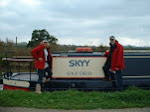True to his word Wayne had four, 25lt containers lined up ready as we moored alongside his wide beam boat. A hand pump neatly discharged their contents into our tank with hardly a drop spilt. Wayne’s business should do well as there are no boatyards for miles in either direction and the marina has no electric hook up all boat owners there have to run their engines or use generators to keep batteries topped up. His Granddad, Elias Grimshaw had worked the canals all his life and the nearby bridge had been named after him so it seemed appropriate that Wayne’s new business should be called after his celebrated Granddad and we wish him success.


We continued through the three locks back into Wigan, on the way I photographed the bronze statue of a very tired looking coalman leaning against the information board at Wigan Pier. We then turned onto the Leigh Branch and up two locks. It was now a straight run into Manchester and whilst I walked along the towpath I saw this lovely cuddle of goslings. The canal is now set high above the surrounding land, as the old coal mine works collapsed the ground sunk and large lakes formed and the canal had to be continually built up resulting in the two locks at Dover Inn disappearing. The only obstruction was the Plank Lane swing bridge, which is now a BW operated lift bridge, immediately beyond the bridge contractors were putting the finishing touches to a large, newly dredged area of water, the use of which eludes me, it could possible be moorings for the nearby pub, but I doubt it, anybody know the answer?


We slowed as we approached the sharp turn at Worsley, this is where the canal network started. The Duke of Bridgewater wanting an easy way to get the coal out of his mines and had a bright idea that floating it out in boats might work, it did and maybe floating it all the way into Manchester would also be a good idea, it was and that in a nutshell is what spawned Britain’s canal mania and the Industrial Revolution. The entrance to these old mine workings are still there in un-navigable waters beyond the bridge passed Worsley Old Hall, the black and white timbered court house. The water here is also bright orange, coloured by dissolved iron ore still leaching from the old mines.


Around the next corner at Parrin Lane Bridge, somebody has thoughtfully erected a lighthouse, apart from saying ‘No To The Incinerator’ as far as I can see, it’s only purpose is to say, that the age of folly building is not totally dead, hoo ray. However the purpose of the Barton Swing Aqueduct that carries the canal over the Manchester Ship Canal is very clear. I don’t know whether there is now any traffic coming up the Ship Canal that would necessitate the aqueduct to be swung, but the fact that it could is amazing.




Passed the Trafford Shopping Centre, the management of which has thoughtfully provided moorings to ensnare passing boaters and a left turn at Waters Meeting and we were back onto familiar waters at we travelled the last couple of miles into the centre of Manchester City with the Ship Canal paralleling us at a lower level. This had been one of our longest days cruising and we were pleased to turn into the moorings at Castlefield only to find it full, we did finally squeeze into a space beside the Merchants Warehouse, albeit shrouded at each end by a willow tree. Pretty!


1 comment:
Hi both,
When we came through plank lane lift bridge in early October last year we were told by the operator that it was to be a new marina??
Carol
Post a Comment